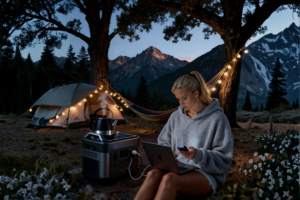How to Choose the Right Solar Generator for Camping
When you’re off-grid, your power setup becomes your lifeline. A solar generator can keep lights on, devices charged, and meals hot — without the noise, fuel, or maintenance of a gas unit. But with dozens of models out there, how do you pick the right one for your trips?
Here’s a field-tested guide from iamcamping on how to choose the solar generator that fits your gear, your pack, and your adventure style.
Step 1: Know What You Need to Power
Before buying, list what you actually want to run. Phones? Lights? A CPAP machine? Mini-fridge? Each has a different draw.
A quick way to calculate your daily power need:
(Device watts) × (hours used per day) = watt-hours (Wh) required.
| Device | Power Draw | Hours/Day | Total Wh |
|---|---|---|---|
| Phone | 10W | 2 | 20 |
| Laptop | 60W | 3 | 180 |
| LED light | 5W | 5 | 25 |
| CPAP | 40W | 8 | 320 |
| Total | 545 Wh/day |
So, a 300–500Wh generator would cover a full day with some margin. If you camp longer than 2 days, plan on a solar panel to recharge while you rest.
Step 2: Understand the Key Specs
- Watt-hours (Wh) tell you how much energy the battery stores. The higher, the longer it runs.
- Watts (W) indicate how much load it can handle at once. Example: 200W continuous / 400W peak.
- Pure sine-wave inverter protects sensitive gear like laptops, CPAPs, and drones.
- Battery chemistry matters. LiFePO₄ lasts longer and is safer; lithium-ion is lighter and more compact.
Step 3: Check Portability and Build
If you’re backpacking or car-camping, size and weight matter. Look for:
- Under 10 lbs for ultralight setups
- Integrated handles or shoulder straps
- Rugged casing and cooling vents
Models like the Flashfish EA150 (166Wh) or GOFORT 330W (299Wh) hit that sweet spot of portability and power.
Step 4: Look at Charging Options
Most portable stations recharge three ways:
- Wall outlet (AC) – fastest method at home.
- 12V car socket – charge while you drive.
- Solar panels – charge anywhere with sunlight.
If you’re camping more than two nights, solar is essential. Check the input specs (usually 12–28V DC) and make sure the connectors match your panel. Brands like Flashfish and GOFORT include adapters for 8mm, 5.5x2.1mm, and 3.5x1.35mm ports.
Step 5: Consider Solar Panel Efficiency
High-efficiency monocrystalline panels (like the Flashfish 100W or GOFORT 100W 18V) convert 21–23% of sunlight into power. Look for:
- Foldable or kickstand designs for better angles.
- ETFE coating for heat and UV resistance.
- Built-in MPPT controller for faster charge cycles.
Step 6: Don’t Skip Safety & Features
A good solar generator includes:
- Over-current, over-voltage, and over-heat protection.
- Short-circuit shutoff.
- Battery management system (BMS).
- Warranty and responsive support (Flashfish, GOFORT, and VEVOR offer 12 months or more).
Also note: smaller units can’t charge and discharge simultaneously — always read your product specs.
Step 7: Match Your Setup to Your Camping Style
Weekend Car Camping
166Wh–300Wh power station + 60W solar panel keeps phones, lights, and cameras topped off.
Example:
Flashfish 200W Power Station + 60W Solar Kit
Vanlife / Long Stays
300–600Wh generator + 100W solar panel for small appliances, fans, and laptops.
Example:
GOFORT 330W Portable Power Station
Emergency Prep / Home Backup
400Wh+ LiFePO₄ system paired with a weather radio and emergency food bundle.
Example:
VEVOR 4000mAh Weather Radio
Final Thoughts
Choosing the right solar generator is about matching wattage and weight to your real needs. Focus on battery capacity, output ports, and solar compatibility — not hype. Once you find the balance, you’ll have a portable setup that powers your adventure quietly, safely, and sustainably.

